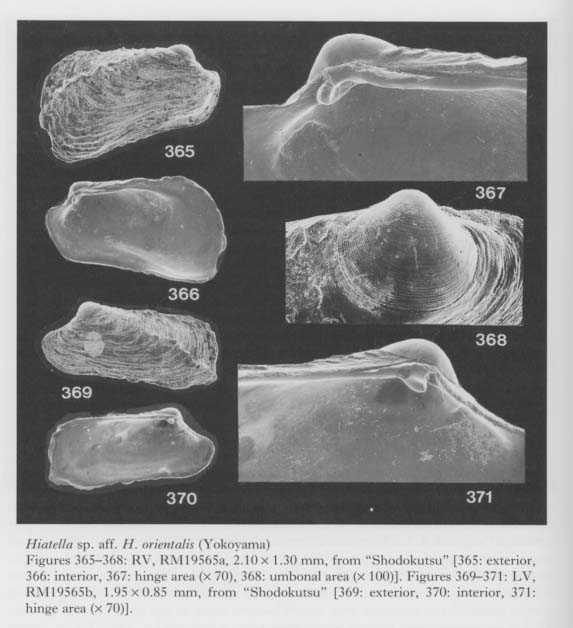Order Myoida Stoliczka, 1870
Suborder Myina Stoliczka, 1870
Superfamily Hiatelloidea Gray, 1824
Family Hiatellidae Gray, 1824
Genus Hiatella Bosc, 1801
Hiatella sp. aff. H. orientalis (Yokoyama)
Figures 365-371

1992. Hiatella sp., Kase and Hayami.Jour. Moll. Studies, vol.58, p,448, listed.
Material.— RM19560 (dead) from "Devil's Palace", RM19561 (dead) from "Fool's Palace", RM19562 (dead) from "Witch's House", RM19563 (dead) from "Toriike" of Shimoji Islet. RM19564 (dead) from "L-arch" of Irabu Islet. RM19565 (dead) from "Shodokutsu" of Ie Islet. No living specimens have been found.
Description.— Shell very small for genus, scarcely exceeding 3.0 mm (in Ie sample) and 5.0 mm (in Shimoji sample) in length, considerably irregular but elongated subtrapezoidal in outline, about twice as long as high, white and opaque in larger but translucent in smaller specimens. Anterior part somewhat reduced; posterior part commonly expanded, Umbo relatively small, located one-fourth to one-fifth of shell length from anterior end. Antero-dorsal margin short, concave in front of beak; postero-dorsal margin long, nearly straight; ventral margin frequently a little concave in middle portion. Surface marked with irregular growth lamellae and two prominent spinose radial ribs in posterior area, which become more or less obscure with growth. RV has an opisthoclinal tubercular cardinal tooth below umbo, while LV is almost edentulous. Ligament opisthodetic, external. Pd I small, ranging 77-103 ×m in maximum diameter; Pd II strongly convex, tinged with pink; veliconch (Pd I + Pd II) ranging 303-361 ×m in maximum diameter.
Remarks.— The irregularly long subtrapezoidal outline and two significant radial ribs on the posterior area in young shells indicate that the present species belongs to Hiatella. As mentioned by Keen (1958), the genus Hiatella is a somewhat difficult group to classify at the species level, because of the high irregularity of shell shape. Although the maximum shell-size is somewhat different between the samples of Ie and Shimoji Islets, the present species seems to be much smaller than any described species of Hiatella in the Pacific regions.
Some juvenile specimens of Hiatella orientalis (Yokoyama, 1920) (see Oyama, 1973, for the synonymy) similarly reveal two spinose radial ribs and a transversely elongated outline. In fact, the cave specimens are hardly distinguishable from juvenile specimens of H. orientalis, which were collected, for example, from the beach of a sand bar of Heta Cove, western coast of Izu Peninsula, central Japan, and dredged from the sublittoral substrata of the Funka Bay of southern Hokkaido. The only marked difference is the preservation of Pd I and II, which is much poorer in the compared juvenile specimens. However, no specimen larger than 6 mm in length has been found in the cave sediments of Ie and Shimoji Islets. There is still a possibility that all the present specimens are immature, but it is likely that they are a product of significant stunting occurred in adaptation to such cavernicolous environments.
Distribution.— Common in several sublittoral caves of Ie, Shimoji and Irabu Islets, Ryukyu Islands.
Subclass Anomalodesmacea Dall, 1889
Order Septibranchia Pelseneer, 1888
Superfamily Cuspidarioidea Dall, 1886
Family Cuspidariidae Dall, 1886
Genus Halonympha Dall, 1886
Halonympha was originally proposed as a subgenus of Cuspidaria but regarded as a distinct genus by Allen and Morgan (1981) on the basis of different anatomical characters. It is also commonly characterized by the presence of a posterior internal platy buttress (called clavicular rib by some authors) for the insertion of posterior adductor muscle. Species of Halonympha have been described exclusively from the bathyal abyssal substrata of the Atlantic and the west Indian Ocean (Smith, 1885; Dall, 1886; Thiele and Jaeckel, 1931; Nordsieck, 1969; Allen and Morgan, 1981). The cave sedi- ments of Ie Islet contains numerous valves of a small-sized cuspidariid, which possesses a similarly well-developed posterior internal buttress in each valve and a tubercular subumbonal tooth in RV. Although taxonomic evaluation of these characters may be controversial, we regard the cave species as the first record of this genus in the Pacific realm.